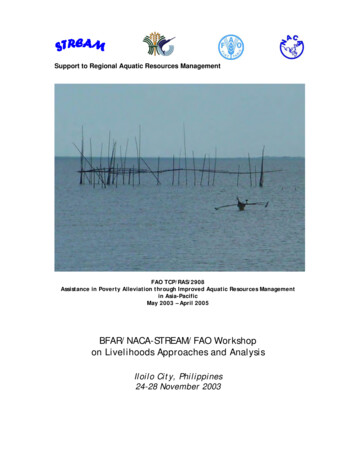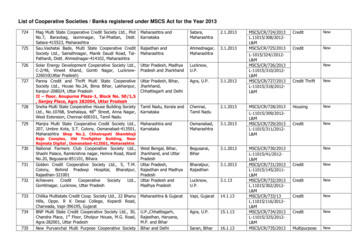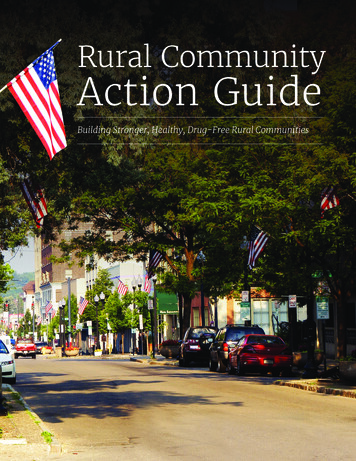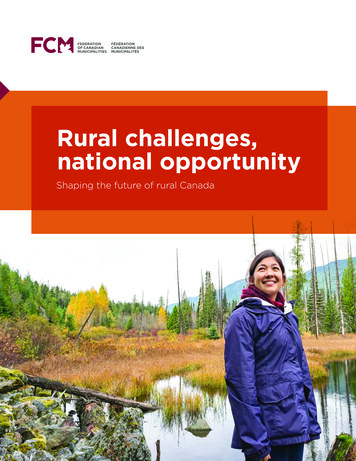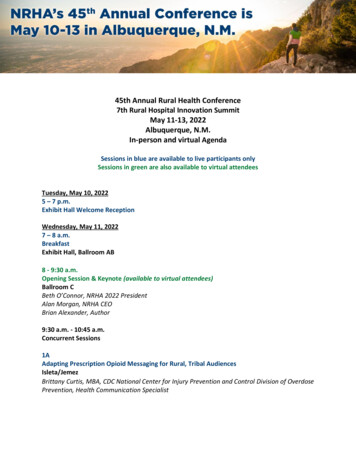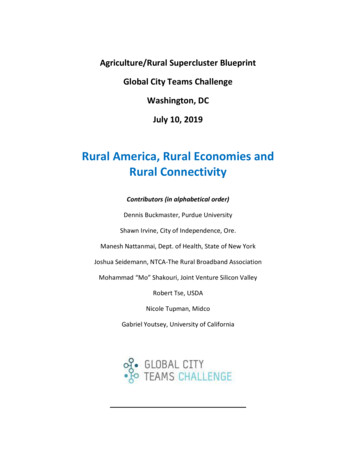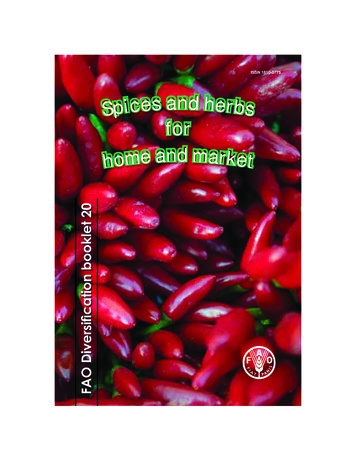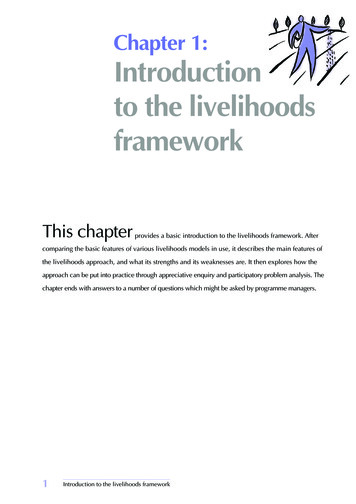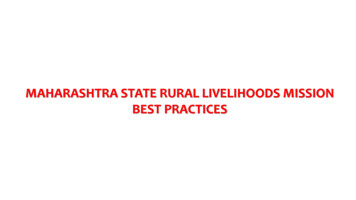
Transcription
MAHARASHTRA STATE RURAL LIVELIHOODS MISSIONBEST PRACTICES
1.Nutri-GardenHomestead Vegetable Garden‘paving way for a healthy life & sustainable livelihood’
IssueIdentifiedImplementing throughDashasutri ModelRegular dietary intake did not ensure the supply offive vital nutrient required by human body forsustenance and well-beingFood NutritionHealth & WASH(FNHW)Objective ofNutri-Garden community-drivenand demand drivenservice deliveryinitiativeRegularMeetings“Special Convergence Project”RegularSavingSustainableLivelihood To reduce poverty through reduction inexpenses for healthcare To increase household income by ensuring theoverall health and well-beingAccessingGovernmentSchemes Support and empower identified marginalizedhouseholds vulnerable to health risks Improve their health and nutrition Reduce cases of low hemoglobin and ntInvolvementin PRIConcept of Nutri ingmaternalhealthIncreasinghouseholdincome byimprovingproductivityReducingabsenteeism inschool itionReducinganemiccasesrecordedacross theStateEnsuringnutritiousdietaryintake forfamiliesUpdatedBooks ofAccountsEducationHealth &Cleanliness
ImplementationProcessIdentification of Community Resource Persons (CRPs) andCommunity Training Consultants (CTCs) in each project blockMSRLM has implementedFNHW programme in 254Blocks of 26 Districts.1270 CTCs have been identified and trained on FNHWConvergence Stimulus FundFinancial ModelRs. 8000(constructionof individual householdlatrines )Rs. 2000(developingindividual or communityNutri-Gardens)Rs. 30000(developingDemonstrative NutriGardens)State-level training and exposure visit toComprehensive Rural Health Project at Jamkhed &Rahuri (Maharashtra state)District level trainings were organized for CRPsalong with exposure visits.Block level trainings were organized for CRPs alongwith exposure visits attended by ICRP, VO leaders,Krushi Sakhis and Anganwadi/ASHA workers.
Layout of Nutri-GardenArea 100 sq.ft
26 districtsOutreach ofthe Project254 blocks7620villages1270 CTCstrained70354 HHsbenefittedModel Nutri-Garden was created in every block for demonstration purpose which is maintained by Block Mission Manager Unit (BMMU)and community cadre associated with it.TargetBeneficiariesTargetAchievedSHG womenPregnantWomenreducerate ofschooldrop outsPreparedIndividualNutri Garden70354PreparedCommunity Nutri –Garden5643PreparedDemonstrative NutriGarden at242LactatingMothersreduceexpenditure on health0-6 BenefitIntake of nutritiousfruits and vegetable indaily dietary intake hasreduced the cases ofanemia registered inthe project area.Increase in Hb from 4grams/deciliter toaround 14grams/deciliter
2. Floriculture:An Income Generation Activity for Small FarmersDistrictsAbout the operational Area Palghar district- Jawhar is a NRLP block located inthe newly created district of Palghar inMaharashtra. Situated in Western Ghats and one of the tribalregion in Maharashtra Agriculture is predominantly rain-fed in spite ofthe fact that area receives more than 2500 mm ofaverage rainfall. Paddy is the main crop grown only during theKharif (monsoon) season. millets/pulses/oilseedcrops are grown. Due to low productivity, farm production is notenough to feed the families for the entire yearand during the off season, tribal families migrateto nearby cities in search of wage labour.Anual Sales Turnover Palghar Thane 15.34 CrSinceInceptionMAHARASHTRASTATE RURALLIVELIHOODMISSION-OUTREACHCoverageBlocks 6 Palghar 2 ThaneVillages 523SHGs 8280 PartnerTechnical BAIF MITRARuralProducer About22134Jasmine WomenfarmersFlower Collection Centre 25 CollectionCenters
Small Scale Floriculture Business ModelJasmin PlotSelling of the FlowerJasmin FlowerPicking up Flowers
Supply Chain Graph of JasminSupply Chain of 794.8630 5.42020142015Number of Members2016Produces in Quintal2017Amount in Lac2018
STRATEGY AND KEY zation and organizationof flower cultivators in a formalproducer groups (FPO).MobilizationMarketing &TransportationSupportSystemPackage of PracticesSupport SystemTechnical Training and Package of Practicesfor Jasmine cultivation .PoPStrategy &InterventionsMicro-CreditSHG Microcredit being used byPoor tribal farmers for land leveling, pit digging andfarm ponds to irrigate the jasmine crop. .Effective forward linkage withefficient transportationMicroCreditSupport for timely flower collection,quality monitoring, control,CollectionCentersCollectionEstablishmentof 25 flower collection center'sCenters
Salient Features of the Model:1.Can be cultivated in Sloppy , waste land2.Limited seed capital required3.Faster income4.Ease of management5.Round the year income6.Value addition potential
3.MSRLM Women FPOs (1/2)#12Name of FPOsPrachiti Banjara Kala andKhawa Womens FarmerProducer Company Ltd.Rani Hira FarmerProducer Company Ltd.NagbhidDistrictNo ofShareholdersCommodityBeed350Khawa andBanjara artChandrapur130Paddy, Tur ,Lakhori3Ecovan Self ReliantWomen Farmer ProducerCompany LtdGadchiroli6504Girija Self Reliant FarmerProducer company Ltd.Gondia4155Dyanjyoti Mahila ShetkiUtpadak companyJalna10106Priyadarshini MahilaShetki Utpadak CompanyJalna1050ActivityBanjara ArticlemanufacturingPaddy processingand tradingPaddy, Vegetable,AgricultureMaizecommodity tradingPaddy, Vegetable, Agri input center,AgricultureGoaterycommodity tradingAgriculturalAgricultureproducecommodity tradingAgriculturalAgricultureproducecommodity trading
MSRLM Women FPOs (2/2)#Name of FPOsDistrictNo ofShareholders7Akkarani Self ReliantFarmer Producer Company NandurbarLtd8198Yashwanti Farmerproducer Company Ltd.Palghar526Vardaini Farmer Producercompany LtdSolapur910 Navi UMED FarmerProducer Company Ltd11Kalamb Mahila ProducerCompany Ltd12 Jivnnoti Mahila ProducerCompany Apple, Maize,Tur, JowarPaddy,Vegetable,FloricultureActivityCustard appleprocessingAgri input centerAgri input center,Tur, Tamrind,Tamarind processingJowarand tradingCotton,Soyabean, TurAgriculturecommodity trading1296Soybean, Tur,CottonAgriculturecommodity trading,Agri input center1300Tur, Seed,Fertilizer &PestisideAgriculturecommodity trading,Agri input centerTotal 12 Crores of business turn over achieved by these FPOs
Livelihoods Saturation of all families Exposure visits Livelihood cycle Demo plots Minimum 5 interventions perfamily and 2 Lakh Incomegeneration per year Convergence with line department Special trainings for livelihoods Support organisations( BAIF, AFARM, GTI,CSA, SSP, BASIX ) NRETP15
Livelihood interventions . Sustainable agriculture / organic farming /SRI/NTFP - 1 (Rs 25,000) Horticulture / floriculture / vegetable cultivation / nutrigardens – 1 (Rs 25,000) Dairy /goatry /poultry /fishery – 1 (Rs 25,000) Vermicompost / nadep / non farm activities -1 (Rs 25,000) DDUKGY / R-SETI mobilisation – 1 ( Rs1,00,000 ) 100% coverage of above 5 interventions for umed fold families Total interventions – 5 Incremental income generation – Rs 2,00,000 /year
Poverty Gap filling (70 % : 30 % ) . Milk/ Milk Product Eggs /Meat/Fish All types of intercultural operations Custom hiring centers ( Equipment bank) Collective purchase and sale for all types of daily needs at village level ( All types ofshops ) Beauty parlor/ saloon / laundry / TV, freeze, mobile, washing machine repairs Midday meal/SNP for anganwadis/Amrut Ahar/Canteen for PHC and sub center
Expected Income generation . 90 % families Rs 10,000 80 % families Rs 20,000 70 % families Rs 30,000 60 % families Rs 40,000 50 % families Rs 50,000 40 % families Rs 60,000 30 % families Rs 70,000 20 % families Rs 80,000 10 % families Rs 90,000
4.ASMITA
SalientFeatures1Empowering women to use mobilebased application2Partnering with Bank to develop app &QR based card3Recharge wallet through Debit / Credit/Rupay /Netbanking / Kendrachalak4End-to-End digital transactionAimTo promote use of menstrual products amongwomen and adolescent girls in rural MaharashtraObjectiveTo ensure access to quality sanitary napkinsTo provide livelihood opportunity through sale of napkinsOutreachAll 34 districts (351 blocks, 27,862 GPs)Achievement 29,180 SHGs registered2,75,302 Asmita cards printed and distributed53,550 school girls purchased Asmita & Asmita Plus1.5 Cr napkins sold to women and adolescent girlsStakeholders Involved RDD, GoMUMED-MSRLMMahaOnlineCSC-SPVYes BankDepartment of Posts, GoISelf-Help GroupsWomen and adolescentgirls 5Revised quality specifications of Asmitapads6Home- delivery of Asmita Plus throughIndia Post7Online inventory management of sale8System-based payment process tomanufacturer’s account9Subsidised Asmita Plus sold at Rs. 5 toZilla Parishad school girls10An initiative promoting alternatelivelihood for sustainabilityAsmita UMED mobile appHome delivery by India PostSale of subsidisedsanitary napkinsusing Asmita cardwith QR codeSale of non-subsidised sanitary napkins at villages
InitiativesTakenLaunch of Asmita Yojana on 8thMarch 2018Digital Literacy training programsacross stateAsmita Rath for popularizing theYojanaRe-launch of Asmita Plus on 8thMarch 2019ToT on MHM at state levelDistribution of sample packets andpamphlets on World MH DayQualityspecifications ofAsmita Plus5/- SubsidisedAsmita Plus24/- Non-SubsidizedRobust MIS formonitoringAsmita PlusExtra LargeSize(280 ctionSustainability ofAsmita YojanaFeatures ofAsmita PlusMoreabsorbency(Min. 70 ml)Durable(min. 4 hrs)Regular qualitycheckDoorstepdeliveryIT componentfor servicedelivery.
DDUGKYBest Practices
5.CRP strategy for effective Mobilization A unique strategy tailored to the needs and requirements of the districts is undertaken and accordingly, amobilization and CRP strategy is created. Based on the strategy, trainings are then provided to BDO’s, Extension officers, Block Coordinators, PIAs, PD,DRDAs for efficient targeting of beneficiaries and stronger mobilization This has helped to create the following positive outcomes: Identification of suitable candidates Sensitization on the need and importance of training through DDUGKY Greater Enrolment of interested and eligible candidates of SHG family members Increased placement of youth through direct interaction Connect of candidate aspirations to employer demandsIn recognition and appreciation of their efforts, all CRP representatives and VO’s receive Rs. 1000 percandidate CRPs – Rs. 800/- (200/- after batch commencement, 200/- completion of training and joining job, 200 /- aftercompletion of 3 months job, 200/- after completion of job for one year). Vos - Rs. 200/- (100/- after batch commencement, 100/- after completion of job for one year
Impact of CRP Strategies The larger impact is yet to be documented. Although,the initial response has been positive and the CRPstrategy have proven to be very successful. So far,since start of the CRP strategy, more than thousands ofthe candidates have been referred to the PIAs for DDUGKY training. There have been instances where PIAshave been assisted by CRPs in enrolment of candidatesthrough successful mobilisation. PIAs have beensharing the IEC and training and placement relatedinformation to district officials for promotion of theirtrainings at DDU-GKY centre. The communication through Nodal Officers havemotivated the district officials to better coordinatewith PIAs and plan for regular monthly review meetingswith PIAs at district level.24/12/201924
6.Resizing and re-allocation of Targetsfor effective Implementation & Monitoring of DDU-GKYProgramSl.No.ParameterStrategy Adopted1.1220 project’s targets were right sized based on theperformance.Target Allocation 2. Allocated to new applicants with 280 target withminimum and PIAs who have their training centeridentified before Pre-PAC with 140 capacity.Fund release12.5% after submission of DDR12.5 % after commencement of the trainingImpact1. Unutilized targets being released and newPIAs allocated the targets for immediatecommencement. In doing this,commencement numbers have increasedfrom 500 to 2000 per month.2. Right PIAs selected for training purposes – atotal of 44 new projects sanctionedaccordingly.15 old projects sanctioned additional targetbased on performance.PIAs are submitting DDR with in time. Trainingcommencement is happening immediatelyafter receiving 12.5% of first installment.commencement numbers have increasedphenomenally.
7.CXO Meet 4 CXO meets conducted in the year 2018-19Sr.No.CXO MeetDateNo of Delegates attended1Retail20th June 2018210 (20 Corporates)2Hospitality20th July 2018220 (30 Corporates)3Multisector IndustryPartnership Summit20th Dec, 2018310 (70 Corporates)4Multistate MultisectorIndustry PartnershipSummit14th June, 2019440 (103 Corporates)26
CXO Meets: Charting a new path under DDU-GKY for askilled Maharashtra Purpose: Greater and stronger collaboration between the public sector and the privatesector Aim: To identify more opportunities for collaboration and to partner with industries underthe aegis of DDU-GKY via concepts such as “Own a Batch”, placement linkages,mentorship, industry exposure visits, internships, lectures, responding to skill needs andforecasting demands. 3 CXO Meets conducted: 1 – Retail Industry; 2 – Hospitality Industry; 3 – MultisectorIndustry Meet (10 industries – IT/ITES, BFSI, Logistics, Security, Manufacturing, Electronics,Healthcare, Beauty and Wellness, Construction and Real Estate, Retail and Tourism andHospitality Approx. 130 Industries present at the CXO; 35 MoUs signed with various industries, 15Letters of Intent (LOIs) received from Industries for manpower requirement of approx.24,000 candidates, own a batch adopted by several industries, approx. 300 students placedin companies Job Melas, Campus Drives and Direct Placements organized forinterface between employers and training providers/ trainees B2B Networking launched for enhanced collaboration andcontinued communication
8. IT Interventions - Objectives To streamline data collection and reporting of off-ERPrequirements To ensure systematic data collection tools available toimplementing partners To ensure systematic data storage and its usage at variouslevels To auto consolidate reporting done at implementingpartners To auto generate reports based on auto consolidation /update of data To timely inform stakeholders at various levels withuniform reporting figures To build ownership at various levels by using easyanalytical tools To build user-friendly decision supportive system24/12/201928
IT Interventions: Outputs & OutcomesOutputs of the IT interventions are as below: Bringing off-ERP database on one platform Systematic communication with stakeholdersalong with ease of tracking of the database /reporting assignments Establishment of User Friendly DecisionSupportive System based on off-ERPdatabaseOutcomes are as below: Well informed stakeholders are in betterposition to take decisions Capacity building of MIS staff at various levelsto handle off-ERP database24/12/201929
THANK YOU
1270 CTCs have been identified and trained on FNHW State-level training and exposure visit to Comprehensive Rural Health Project at Jamkhed & Rahuri (Maharashtra state) District level trainings were organized for CRPs along with exposure visits. Block level trainings were organized for CRPs along with exposure visits attended by ICRP, VO leaders,
